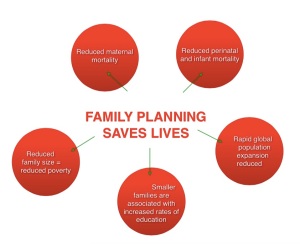Edna Adan’s vision, in building her hospital, was to reduce maternal and child mortality by providing maternity care. Our mission in travelling to Hargeisa is to win over hearts and minds on the topic of reproductive health. Whilst effective maternity care is the first step in reducing both maternal and child mortality, effective family planning reduces this further, by increasing the chances of healthy pregnancy, healthy childhoods and reduced levels of poverty and famine.
1. Spacing of pregnancies reduces maternal mortality Women who become pregnant less than 5 months after giving birth are 2.5 times more likely to die of a pregnancy related cause than a women who is able to wait 18-23 months. Women who have shorter birth intervals have increased rates of both infection and premature rupture of membranes.  2. Birth spacing reduces childhood illness and mortality Children born less than 2 years after a sibling are 2 times more likely to die within the first year of life than those born 3 or more years later. Shorter birth intervals also affect children when they are older with increased rates of malnourishment. These children also have a greater risk of dying of infectious diseases such as pneumonia and diarrhoea 3. Reduced family size reduces malnourishment and poverty making sure there is ‘enough to go round’ 4. The human species is remarkably successful, having now reached an estimated 7 million population.
2. Birth spacing reduces childhood illness and mortality Children born less than 2 years after a sibling are 2 times more likely to die within the first year of life than those born 3 or more years later. Shorter birth intervals also affect children when they are older with increased rates of malnourishment. These children also have a greater risk of dying of infectious diseases such as pneumonia and diarrhoea 3. Reduced family size reduces malnourishment and poverty making sure there is ‘enough to go round’ 4. The human species is remarkably successful, having now reached an estimated 7 million population.  In a world of finite resources, the population will stop growing at some point – either the humane way, by fewer births – or the inhumane way by more deaths from famine disease or war.
In a world of finite resources, the population will stop growing at some point – either the humane way, by fewer births – or the inhumane way by more deaths from famine disease or war. 
